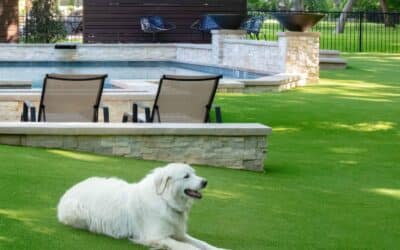If you’re weighing up the pros and cons of switching from real grass to synthetic grass and wondering what the main differences are, bear in mind that artificial grass and turf also have differences.
The main difference is found in the intended purpose of the turf or artificial grass. This leads to many differences in composition and materials. In a nutshell, turf usually refers to the type of synthetic grass found on sports fields while artificial grass is a more general term for the landscaping surface used in backyards and businesses across the country.
However, you will enjoy many of the same benefits whether you install artificial grass or turf.
Before you make your decision between turf and artificial grass, numerous factors should be considered. Here’s what you need to know…
A More Sophisticated Turf Market…
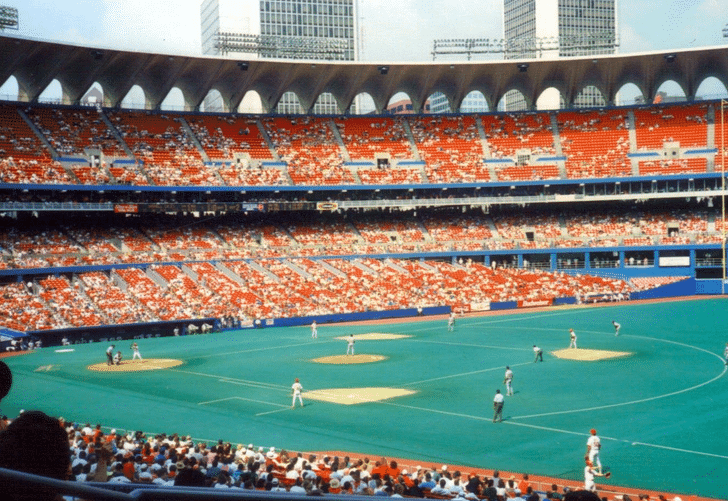
You may hear “turf” and “artificial grass” used interchangeably. In many cases, that’s OK because it simply distinguishes the artificial varieties from real grass, which is very different.
Back in the 1960s and 1970s, only AstroTurf was available and it was mainly used in sports stadiums and other types of large venues. It was green but didn’t look very much like the real thing—and, unfortunately, this image has tarnished many people’s understandings of what can be achieved with artificial grass today.
In the past decade or two, however, the synthetic grass market has become far more sophisticated. Advances in manufacturing technology and the materials available provide a great many options for homeowners and commercial property/business owners considering the switch from high-maintenance real grass.
So, when comparing the qualities of artificial varieties of grass, we need to make a few more distinctions between turf and artificial grass.

Turf vs. Artificial Grass
Not all manufactured grass is the same. Let’s look at the main differences between turf and artificial grass…
What Is Artificial Turf?
Artificial turf is essentially sports turf. It is strong, hardy, and can withstand the wear and tear of the consistent beatings it must take from football, baseball or soccer players.
This turf usually has a shortish pile height and is made for durability more than appearance—though improved technology has greatly improved the appearance compared to previous varieties too. Its use in many NFL sports stadiums across the country tells you all you need to know about quality.
Just as sports grass is cut shorter and designed for players to be able to show off their talents, the best artificial turf closely mirrors the appearance and qualities of sports grass—without the need for sunshine, watering, and constant maintenance. Turf also remains even and level (potentially reducing injuries) and is less affected by the challenges of the weather than real sports grass.

What Is Artificial Grass?
Artificial grass is a type of landscape turf with a longer pile height and a lusher, more cushioned feel and realistic appearance than sports turf.
The best artificial grass looks very similar to the real thing with a range of colors from olive green to emerald green and an inviting appearance designed to closely emulate real grass. This type of grass is made with appearance in mind but that’s not to say it’s not durable. Artificial grass can still last 15-20 years or more if it’s looked after properly.

Three Main Differences Between Artificial Grass and Turf
Intended Usage
Nearly all turf is made for action. Whether that’s in a professional NFL sports stadium, a college football stadium, or in a public park at a strictly amateur level, turf is built to stand up to the rough and tumble of action sports.
The area can be as expansive as the AT&T Stadium in Dallas or as limited as a mini-soccer pitch for the kids in the backyard.You might even see it as a playing surface for less active sports—increasingly for backyard putting greens and bocce ball courts.

Artificial grass is intended for a wider variety of activities—from simple backyard lawn landscaping to playgrounds, swimming pool areas, entertainment areas, dog-runs, pet-care facilities, and more.
This type of synthetic grass needs to look good and, if it does, it can even add value to a home because it adds curb appeal and tends to look pristine all year round with virtually no effort.The realistic appeal of artificial grass is usually aided by a layer of brown thatch running beneath the main grass fibers.
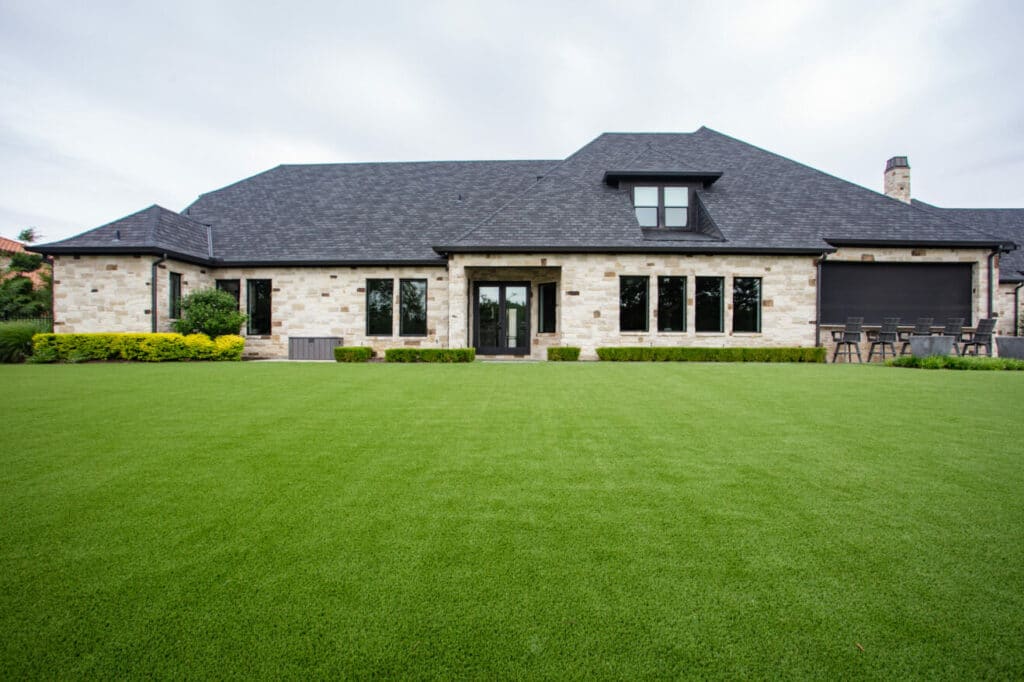
Composition and Materials
Artificial grass and turf have the same basic manufacturing process and components. Both have blades made from artificial plastic fibers stitched into a backing material which also has a second backing layer in the form of a binding material.
Both also require a type of infill to be added after installation. This keeps the grass blades upright and creates a more realistic appearance. However, the type of infill used will depend greatly on usage. It could be sand or rounded silica granules, crumb rubber, zeolite-based, antimicrobial or another type of infill.
Sports turf requires extra ground preparation with a layer of shock-absorbent material underneath it in addition to the standard sub-base layer of crushed rock. This provides cushioning for falls and reduces injuries. Most artificial grass installations don’t require this unless the intended usage is for a kids’ play area.
The best sports turf these days tends to be made from monofilament polyethylene-blend fibers tufted into a polypropylene backing. However, you may see nylon used in some venues because of its legendary resilience and durability.
Artificial grass for landscaping is usually made from polyethylene or polypropylene or, for the less budget-conscious, nylon. At Artificial Grass Pros, we usually recommend polyethylene-based grass because it balances the benefits of durability and appearance while remaining easy on the pocket.

Main Qualities
The intended usage and manufacturing process will largely determine the main qualities you look for in either turf or artificial grass.
Note that the product quality and workmanship for both turf and artificial grass can vary. Whether the final installation meets expectations in terms of appearance and durability will depend on both the products used and the team who installs them.It’s essential to speak to the right artificial grass/turf professionals about your installation. That way, you will get reliable advice and choose the right product for your needs, book the right installation team to make your idea a reality, and ensure your grass area lasts the distance.
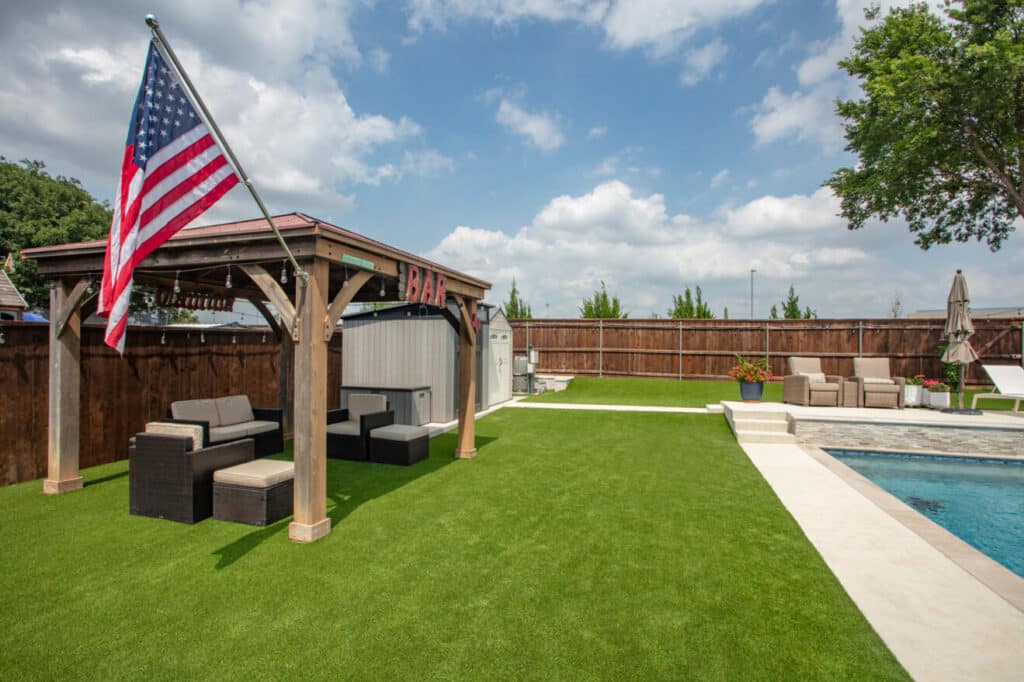
In terms of the product itself, the turf or grass will differ in the following qualities:
- Pile height: shorter pile heights for sports turf range from 0.6 inches to 1.5 inches while artificial grass pile heights generally range from 1.5 to three inches.
- Face weight (weight of grass blades only): most high-quality sports turf has a face weight of between 50 ounces and 80 ounces per square yard while high-quality artificial grass face weight comes in between 60 ounces and 90 ounces per square yard.
- Total weight (grass blades and backing): Because of the extra lush appearance of artificial grass over sports turf, it may also have a correspondingly higher total weight than sports turf.
- Density: most high-quality artificial grass has a density of 15,000-18,000 stitches per square meter. For sports turf, this figure is usually lower—around 9,500-12,000 stitches.
- Color: sports turf is often a duller green than the vibrant, emerald green frequently requested by homeowners for their lawns and swimming pool areas.
Safety is an extra consideration for sports fields and play areas—but this is more likely to affect the type of installation you choose rather than the turf or grass type.

Turf and Artificial Grass: Some Differences—But Many of the Same Benefits
Despite the differences between turf and artificial grass, there are many similarities too. And the most important benefits are common to both types of synthetic grass.
More specifically, these are:
- Cost savings over time: compared with real grass, synthetic varieties are more cost-effective and pay back the installation costs after around five years.
- Ultra-low maintenance frees up time and resources: artificial grass/turf requires no seeding, watering, mowing, trimming, fertilizing or pesticides.
- Lower water and fuel bills: because artificial grass/turf requires no watering or lawnmowers, it saves on both water and fuel bills.
- Perfect appearance all year round: synthetic grass looks fine all year round without you lifting a finger.
- Environmental friendliness: synthetic grass varieties are recyclable (though not biodegradable) and use fewer resources and chemicals than real grass.
- Long lifespan: most high-quality, professionally installed artificial grass surfaces are highly durable and will last 15-20 years or more.
- No grass allergies: with artificial grass/turf, fewer allergens and toxins mean fewer health problems.
Another benefit of artificial grass (though not generally for turf) is that pets can use it the same as humans—and it’s easy to neutralize pet pee smells if you get it professionally installed.
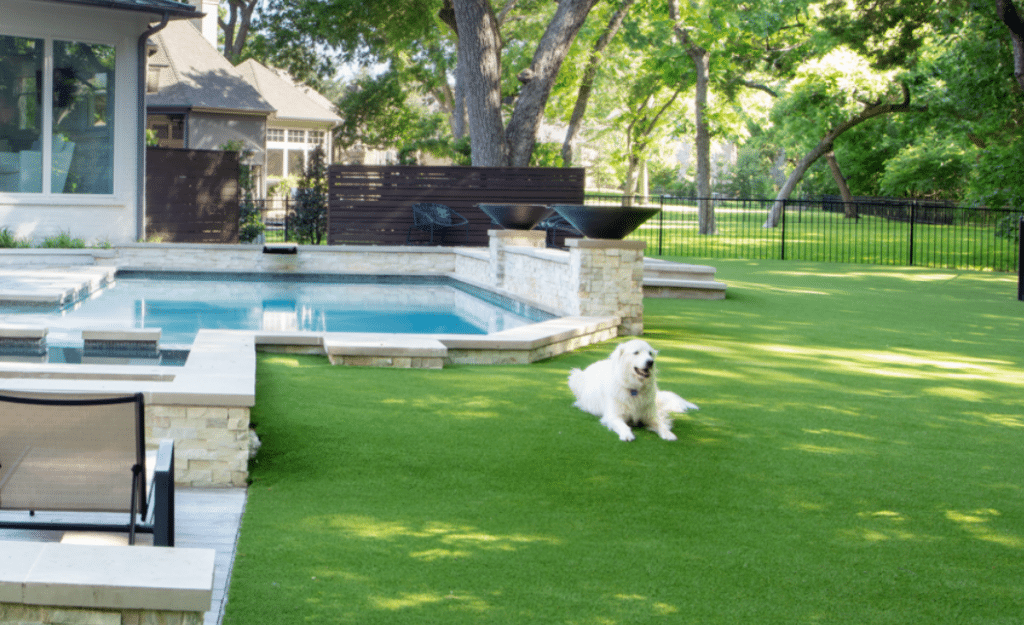
FAQ’s
Which is better, artificial turf or grass?
One is not better than the other—whether you choose artificial grass or turf, the quality varies from manufacturer to manufacturer, brand to brand, and installation to installation. The trick is to work with professionals who understand your needs, budget, and preferences.
Artificial grass tends to be better for lawns and other backyard/front yard uses while turf is generally better for sports fields.
Is it cheaper to install turf or artificial grass?
The cost per square foot of artificial grass and turf (fully installed) varies with the quality of the product and the installation. They are not all created equal so do your homework and find the quality you need.
Is artificial grass worth the money?
Artificial grass/turf costs more upfront than real grass but both homeowners and commercial sports venue owners find that it is worth the money from the reduced maintenance and resource costs over the years following installation.

Customized Artificial Grass and Turf Areas…
Whether you choose artificial grass or turf, you’ll enjoy many benefits over real grass if you match the right products with a professional installation team.
Your choice of artificial turf or grass will largely come down to the intended usage. Most likely, sports will mean turf and lawn or other usage will mean artificial grass.
Either way, you’ll need to speak to professionals who can evaluate your needs, recommend the best grass, prepare your outdoor space, lay the artificial grass, and clean up the site.
The team at Artificial Grass Pros can help you create a custom-designed outdoor area. If you’re considering the switch to turf, discuss your options with an artificial grass professional.


